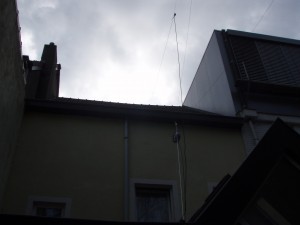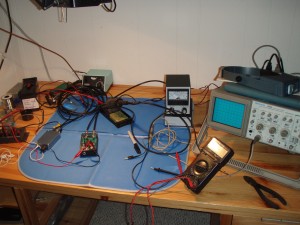We interrupt coverage of Operation Sizzling Pork for this brief mention of last night’s NAQCC sprint, which turned out much better than I would have had any reason to expect. This is a monthly two-hour QRP sprint in which I have participated a half dozen times, usually netting only a few contacts. When I got home from work last night, I remembered the sprint, but was not very optimistic: both main rigs, the antenna tuner, and my keyers are in Indiana, plus a thunderstorm was predicted for prime operating time that evening. However, by the end of the contest, I had made more QSOs than ever before.

With the vintage Collins gear still out for repairs, I had two choices: my 40m rockmite (550 mW) or my ~4W TenTec 1320. The rockmite seemed a bit light for my purposes, so I went with the TenTec. There was one problem, though: the stealth vertical in the backyard is not resonant on 20m, the TenTec’s only band. As of last month, our attic has a newly installed floor, so I strung up a simple dipole from the rafters. I used the former “Belgian Vinegar” antenna, and shorted the radiating wires to sixteen feet, seven inches (calculated for resonance on 14.060). The BVA was basically a dipole center connector plus a gallon vinegar jug wrapped with coax to make an air-core current choke. I wasn’t worried about RF running down the cable in the current installation, so I uncoiled the coax and discarded the vinegar jug. I had used this antenna for two years in Belgium, and during one contest when I operated from Mount Vernon, NY.

I didn’t attempt to run coax down to the basement, but just down through the trap door and into the bed room, where I borrowed my wife’s computer desk. Her iMac was temporarily pushed to the side to make room for the station. I did not have an antenna analyzer or VNA, but I did have a power meter that measured forward/reverse power, so in the fifteen minutes before the event, I trimmed the antenna old school, calculating the vSWR. I got it down to about 1.8:1, and figured that was good enough. I was sweaty and itchy from fiberglass and didn’t want to mess anything up right before the contest, so I left well enough alone. With a 25 foot cable, I figured there wasn’t enough power loss to worry about, even at QRP.
Out the window, I could see lightning flashes, and under ordinary conditions, I would not have used the outdoor vertical. However, given that the dipole is indoors and lower than the various metal projections on my roof, I figured I was okay working through the storm. Loud static crashes interrupted work all evening. After each crash, the radio’s AGC would kick in and I’d be deaf for a couple of seconds as sensitivity recovered. Despite the QRN, reception was fantastic on 20m.
I worked eastern and central North American stations in the first half of the contest, as with the vertical antenna, Minnesota and Texas came in particularly well. Around 01:20Z, propagation went long, favoring western stations, particularly Oregon. I was pleased to work NAQCC members in both Canada (Saskatchewan) and Cuba during the contest.
In all, I had 17 QSOs, although I noted that the last one was a repeat, probably trying to be sure that I had copied him correctly on the earlier exchange, so I can say that I have 16 QSOs that count towards a score. All of my contacts were with members, so 2 points each, and made using a straight telegraph key, so a 2x multiplier. I think I did pretty well this week both in absolute score and likely in relative score since I presume that some of the heavy hitters were on the road to attend the Dayton Hamvention.
I was impressed by the performance of the attic dipole, which was refreshingly free of man made noise, versus my usual operation on the lower bands with the vertical antenna. Over the summer, I am hoping to refine the attic installation and make it permanent, routing the wires down to the station in the basement.
















 couldn’t see where it landed after I gave it a toss. There were a couple tense moments when I went looking for it outside and found it dangling 20′ above the driveway, over the heads of some oblivious guests. I managed to yank it back a bit and get it into the bushes. Later that night, after dark, I guyed it down more substantially. Most of the antennas was elevated at about 35′, with the distant end down lower. I ran a 35′ counterpoise around the room and tuned the whole thing with a
couldn’t see where it landed after I gave it a toss. There were a couple tense moments when I went looking for it outside and found it dangling 20′ above the driveway, over the heads of some oblivious guests. I managed to yank it back a bit and get it into the bushes. Later that night, after dark, I guyed it down more substantially. Most of the antennas was elevated at about 35′, with the distant end down lower. I ran a 35′ counterpoise around the room and tuned the whole thing with a